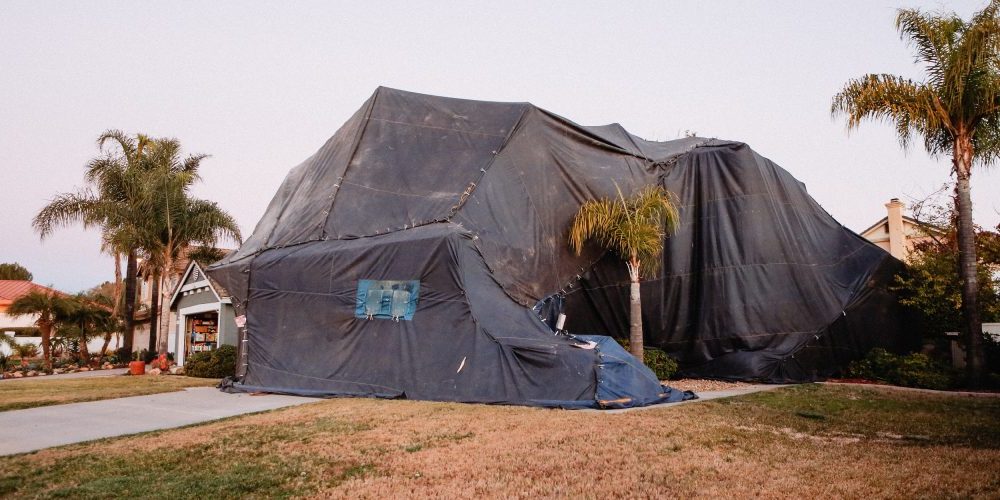 Termite tent fumigation effectively eliminates existing termite infestations and prevents future infestations. However, it’s essential to understand that this pest removal method is not foolproof. Taking proactive measures will keep these pests from entering your home in the first place. Fix any leaks immediately and regularly inspect dark, damp spots such as basements and dingy corners of the house.
Termite tent fumigation effectively eliminates existing termite infestations and prevents future infestations. However, it’s essential to understand that this pest removal method is not foolproof. Taking proactive measures will keep these pests from entering your home in the first place. Fix any leaks immediately and regularly inspect dark, damp spots such as basements and dingy corners of the house.
It’s Effective
Termite tent fumigation uses powerful chemicals that penetrate every area of your home. The gases permeate through walls, cracks, crevices, and dry wood termite tunnels to kill all the insects inside your structure. This is especially helpful in eliminating dry wood termite infestations that don’t require soil contact and have adapted to the drier conditions of our homes. Tent fumigation is effective against subterranean and dry wood termites because it covers the entire structure and can reach areas difficult to treat with other methods, such as heat treatment. However, before a termite tent fumigation takes place, it’s best to have a professional inspect and determine your infestation level. To prepare for termite fumigation, remove all food, water bottles, and other items from your property. It would be best to rake gravel away from your house’s perimeter and secure valuables before leaving for the fumigation process. It would be best to shut off the pilot lights on appliances to prevent accidental fires while you’re out of the home for termite fumigation.
It’s Environmentally Friendly
Tent fumigation is a safe and environmentally friendly way to eradicate dry wood termite infestations. After fumigation, chemicals like sulfuryl fluoride are vented out of the building and into the air, dissipating quickly. This means that there is no residual toxicity left behind in the environment. Before fumigation begins, you must prepare your house by bagging all food, drinks, and medicines not sealed with the manufacturer’s original seal. You must also remove your pets (hamsters, goldfish, lizards) and house plants. Once the fumigation process is complete, your pest control company will test the air in your home to ensure it’s safe for you and your family to return. While there are other, less toxic options for eradicating dry wood termite infestations, tent fumigation is one of the most effective. Other methods, like baiting, require you to remove the whole house and leave it vacant for a while, which can be unsafe for your family.
It’s Safe
Severe termite infestations, such as those caused by dry wood termites, can cause extensive and costly damage to your home or business. Unlike subterranean termites, which require moisture from the ground to survive, dry wood termites get all their nourishment from the wood they consume. Call a professional immediately if you have spotted signs of a severe termite infestation like hollow-sounding wood, fecal pellets, or bubbling paint and wallpaper. Tent fumigation, also called whole-structure treatment, allows homeowners to eliminate pests and prevent them from returning. This option is best for severe pest infestations, such as those involving dry wood termites, which are difficult to treat with localized methods. Tent fumigation involves encapsulating the structure and releasing a colorless and odorless gas to penetrate every building crevice. Once the gas reaches all areas of the structure, it chokes the pests and leaves no surface residue or odor. This process usually takes three days and two nights to complete.
It’s Affordable
Tenting is recommended for severe, widespread, and partly inaccessible dry wood termite infestations. Milder infestations are usually treated with termiticides injected directly into the wood or localized heat treatment.
During fumigation, your pest control professional will place tarps over the structure and pump in a toxic gas to these wood-eating pests. The gas circulates throughout the home to reach cracks and crevices where termites hide, killing them. When the process is complete, your pest control expert will remove the tents and let you know when you can re-enter your home. You’ll need to take precautions with your pets and plants as the fumigation chemicals can affect them, too. Alternatively, some homeowners choose a “tentless” termite treatment. This treatment uses safer pesticides and doesn’t require you to leave home. It may also be more affordable than fumigation. Your pest control specialist can help you decide which option is best.






